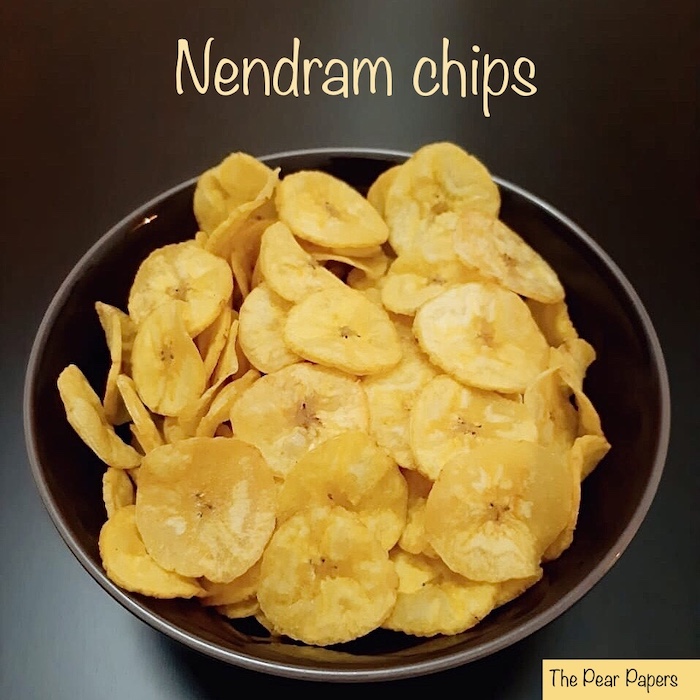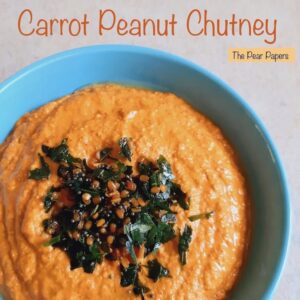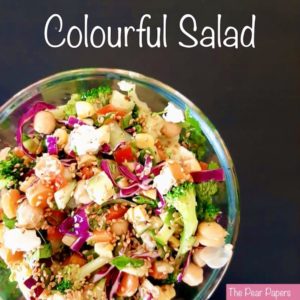
Nendram Chips
Nendram chips are a jewel of Kerala (a southern state in India) cuisine. With just three ingredients, this is a salted chips variety, made from a unique type of plantain, that grows mostly in Kerala. Firm, unripe, green skinned, plantain is thinly sliced and deep fried in fresh coconut oil. Mildly salted, very crisp, with the aroma of coconut oil, it is very addictive and a great favourite in my family.
My association with this kerala style nendram chips dates back to my school days. Those days watching movie in a theatre was very rare and even when we went for a movie occasionally, my dad never allowed us to buy snacks or chips or anything from the small eatery just outside the theatre hall, due to hygiene reasons. Instead he used to buy these tasty nendram chips and a few other snacks from a shop near our house and bring it to the theatre. Watching a movie in the theatre was one thrilling experience (because of the rarity) and enjoying this nendram chips was another thing we all looked forward to.
I’m happy to share this yummy Kerala Nendram Chips recipe, in fond memory of my childhood theatre experience.
Ingredients
Unripe Nendram Banana – 4
Coconut oil for frying – as required
Salt – 1 1/2 tsp (or to taste)
Turmeric powder – 1/2 tsp (optional)
Water – 60 to 70 ml
Yield
Serves 4
Special requirements
A good vegetable slicer
Prep time
15 mins
Cook time
30 mins
Method
1) Wash and trim the ends of the nendram banana. Make slits on the raised edges, along the entire length of the banana. After the slit is made, the skin can be peeled off easily by hand. If you are not comfortable with this process, then peel off the skin either with a vegetable peeler or using a knife.
2) In a small bowl take the water, add the entire amount of salt and turmeric powder (if you are using) and mix well until the salt dissolves completely. Set aside.
3) In a heavy bottomed pan or kadai heat the coconut oil until medium hot. When the oil is heated, very carefully hold the vegetable slicer/chips cutter on top of the pan (a couple of inches above the pan) and start slicing the nendram banana directly into the oil. (See note 5 for tips) The slices should be approximately 1 mm thick – too thin and the chips will be brittle, too thick and the chips will be soggy.
4) Fry the nendram chips until it is almost done and the bubbling is reduced reasonably (about 2 mins or less). Now add 2 tsp of salt-turmeric solution into the oil. Be careful, the oil will start to sputter when you add this solution into hot oil. If you are new to this technique, as soon as you add the salt-turmeric solution, cover the pan with a slotted plate or hold a lid slightly above the pan until the splattering stops.
5) By the time the sputtering stops, the nendram chips will be crispy ready to take out.
6) Remove the nendram chips from oil, drain it in a colander. Continue the same process of frying for all the remaining bananas. Let the chips cool down and come to room temperature. Store it in airtight container and enjoy it any time of the day – like I do 🙂
Notes
- To test if the oil is hot enough, gently drop just 1 slice of the banana into the oil. If it rises from the bottom of the pan to the surface in just about 4 to 5 seconds, then it means the oil is ready to fry.
- I generally peel the skin of the nendram banana with my hand. One disadvantage in this method is, the fingers will stain and become black (unripe banana has the tendency to stain). It will take a couple of days for the stain to go from your hand. To avoid this, you can apply coconut/sesame oil in your hand while doing this. Just be extra careful while slicing the banana, your hands might be slippery due to the oil.
- Adding turmeric is completely optional. It gives a bright yellow colour to the chips. Taste will not be affected if you don’t add turmeric. Also, the salt should dissolve completely in water. You can make the salt-turmeric solution couple of hours before, this way the salt will dissolve completely.
- Slicing the nendram banana directly into the hot oil is the best way to avoid the slices sticking together in the oil. If the slices stick together in the oil, then it will not be fried properly and will not be crisp. Also, do not add too many slices in the oil and make it over crowded. This way too the slices will stick together in the oil and will not get fried properly.
- Add the salt-turmeric solution only when the bubbling reduces a bit (meaning the chips are almost done). It will have the double frying effect. This way the salt and turmeric gets evenly distributed in the chips and there is no need to add salt after frying.
- For each batch of chips you fry, you will add the salt-turmeric solution. If you’re making several batches, taste the chips after every batch to make sure that they’re not getting saltier. If you feel like the chips are getting salty, reduce the salt-turmeric solution for the next batch.
- Kerala nendram chips tastes best when fried in coconut oil. But, you can also use any oil which is suited for deep frying (though I highly recommend to use coconut oil for the authentic taste of nendram chips).
Beginners’ tips
- Always keep a bottle of water in the fridge when you decide to do deep frying. In case of accidental splashing of hot oil or any kind of burn injury, immediately wash the affected part with cold water as a first aid measure.
- Coconut oil is highly suited for deep frying (because of its high smoke point) and can safely be reused a couple more times for shallow frying or tempering. The oil we use to make this chips can be stored and reused for any south Indian dry vegetable curry and coconut based gravies. It adds great flavour to your coconut based dishes.
- Keep the oil in medium heat constantly. If oil is too hot then the nendram chips will quickly turn dark without becoming crisp fully. If the oil is not hot enough then the chips absorb a lot of oil and become soggy.


You May Also Like

Carrot Peanut Chutney
May 14, 2023
Colourful Salad
December 30, 2020